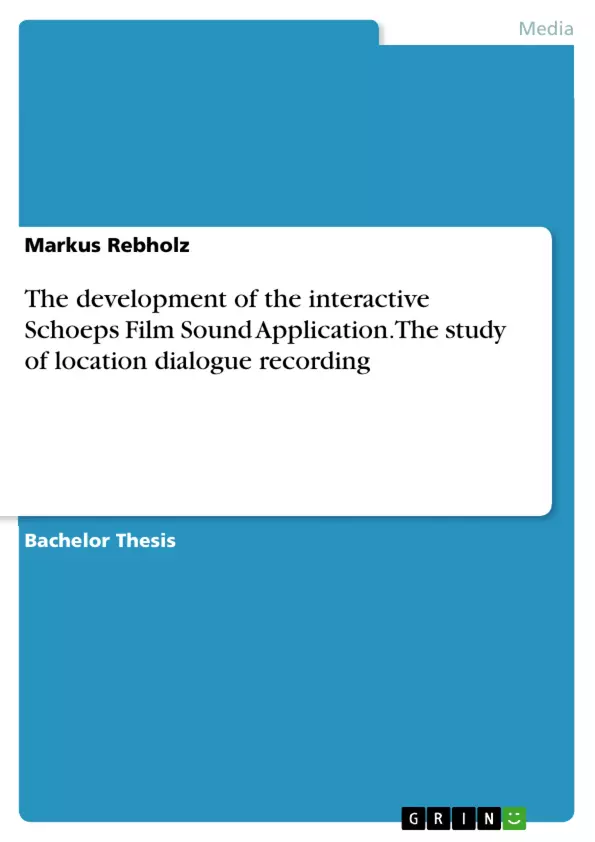This thesis describes the development of an interactive online tool which comprehensively informs production sound mixers about microphones and their proper application for professional dialogue recording on location. The first chapter contemplates the fundamental characteristics of the human voice as the primary sound source. The technical specifications of all used microphones are going to be introduced and their suitable deployment in different both typical and rare situations are being described in detail. An important part of the thesis is the creation of five short films in order to give a practical demonstration of all theoretical aspects. For presentation purposes a complex individually designed video player was built, using up-to-date HTML5 technology. The player allows the user to smoothly switch between multiple audio tracks while playing the video to gain an in-depth view of the function of the different microphones and their behavior.
The thesis was made available for the web presence of Schoeps under the category “applications”. It is the groundwork of a new resource for film sound; an ongoing and growing project with lots of different authors in the future.
Inhaltsverzeichnis (Table of Contents)
- Introduction
- The Human Voice
- Steps to Create Voice
- Timbre, Formants & Loudness
- Male vs. Female Voice
- Intelligibility and Directivity behavior of Sound Field around the HumanTalker
- Microphones Used for Location Sound
- Transducer principle, frequency response, polar pattern
- Fulfill requirements
- Boom Microphones
- Lavalier Microphones
- Planted Microphones
- Placing the Microphone
- Boom Positions and Techniques
- Lavalier Positions and Techniques
- Planted Positions and Microphones Techniques
- Sound Improvement
- Field Tests
- Test #1
- Test #2
- Test #3
- Test #4
- Test #5
- Creating the Film Sound Application
- Elements
- Using the Elements
- The Application as a whole
Zielsetzung und Themenschwerpunkte (Objectives and Key Themes)
This thesis aims to develop an interactive online tool for film sound mixers, providing comprehensive information about microphones and their application for dialogue recording on location. This tool is meant to be a valuable resource for professionals in the film industry, offering practical insights and demonstrations.
- Understanding the human voice as the primary sound source
- Exploring the technical specifications and characteristics of various microphones
- Demonstrating microphone placement techniques for optimal dialogue recording
- Creating a user-friendly interactive application for learning and experimenting with film sound techniques
- Contributing to the ongoing development of a comprehensive resource for film sound knowledge.
Zusammenfassung der Kapitel (Chapter Summaries)
The introduction sets the context for the thesis, highlighting the importance of dialogue recording in film and the ongoing need for advancements in this area. It also introduces the Schoeps company and their commitment to providing high-quality microphones and resources for sound professionals.
The chapter on "The Human Voice" delves into the fundamental characteristics of the human voice, covering aspects like voice production, timbre, formants, and intelligibility. This chapter provides the foundation for understanding how microphones interact with the human voice during recording.
The "Microphones Used for Location Sound" chapter explores the technical specifications and characteristics of different types of microphones used for film sound. It covers transducer principles, frequency response, polar patterns, and specific applications of boom, lavalier, and planted microphones.
The "Placing the Microphone" chapter focuses on practical techniques for positioning microphones for optimal dialogue recording. It covers boom positions, lavalier placement, and sound improvement strategies.
The "Field Tests" chapter presents a series of practical demonstrations of microphone placement and recording techniques, showcasing the real-world application of the concepts discussed in previous chapters.
The "Creating the Film Sound Application" chapter describes the development of the interactive online tool, outlining the elements, functionality, and overall design of the application.
Schlüsselwörter (Keywords)
This thesis focuses on the following key areas: film sound, dialogue recording, microphones, location sound, interactive online tool, HTML5, Schoeps, production sound, sound design, audio engineering, film production, interactive learning.
- Quote paper
- Markus Rebholz (Author), 2014, The development of the interactive Schoeps Film Sound Application. The study of location dialogue recording, Munich, GRIN Verlag, https://www.grin.com/document/320499



